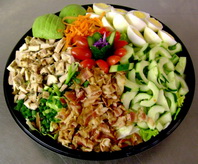Posts tagged diet

Important Things To Know About Low Carbohydrate Diets
0
 A lot of media attention focused on low carbohydrate diets in the last few years and many of our readers asked us about this kind of diet lately. As a result, we decided to do some research online and to present you with some facts and recommendations when it comes to this kind of diet.
A lot of media attention focused on low carbohydrate diets in the last few years and many of our readers asked us about this kind of diet lately. As a result, we decided to do some research online and to present you with some facts and recommendations when it comes to this kind of diet.
Let’s start with some facts:
– Carbohydrates are nutrients that supply the body with the needed energy for maintaining vital functions. The recommendations of Health Canada are that adults take 45%-65% of their total calorie intake from carbohydrates, about 20%-35% from fats and the remainder from protein.(1)
– A carbohydrate-rich diet should be based on grains, fruits and vegetables, as well as meat, milk and legumes, according to Canada’s Food Guide to Healthy Eating.
– Carbohydrate containing foods are also rich in vitamins and minerals such as vitamin C, calcium, potassium, magnesium, iron, folate and vitamin B. By avoiding carbohydrates, you expose yourself to potentially dangerous vitamin and mineral deficiencies. (2)
– Some of the carbohydrate-rich foods such as brown rice and whole grains contain fibre, essential for the good functioning of the digestive system, as well as for the regulation of cholesterol and blood sugar levels. (1)
– Even low carb diets include a certain amount of carbohydrates. It is recommended that you avoid diets based exclusively on fats and protein.
– A fat-rich diet can lead to an increase of the risk of stroke and heart disease, so you should avoid getting more than 35% of your daily calories from such foods that are rich in saturated and trans fat.
– Individuals can decrease their risk of heart disease or stroke by switching to a diet based on foods with a high amount of fibre and a low fat content. Such foods include fruit and vegetables, legumes and whole grains. (3)
– Regular exercise and an adequate nutrition are the main elements that help lowering the heart disease risk. (4)
– If you balance your food intake with physical exercise, you can also control your weight. Less food and more exercise will lead to weight loss. Health Canada recommends Canadian citizens to actively contribute to maintaining their health and well-being by exercising regularly and by switching to a healthy nutrition. (5) (6)
– Unfortunately, most individuals who try to lose weight ignore these recommendations and choose low-carb diets with very little physical activity instead. (7)
– The elimination of carbohydrates from the diet has negative health implications on long term.
Basic Recommendations
The below recommendations are addressed to Canadian citizens. Nonetheless, they can be successfully followed by US residents as well.
General recommendations from the heart and stroke foundation of Canada for the general population:
1. Do not follow a low carbohydrate diet for purposes of weight loss. Such diets are usually very rich in saturated and trans fats.
2. Attempt reaching a normal weight by combining a healthy diet with regular physical exercise. This is what you should do:
a. Choose a physical exercise that’s appropriate for your age and fitness level and perform it 30 minutes a day, every day.
b. Switch to a balanced diet, as instructed by Canada’s Food Guide to Healthy Eating. Basically, such a diet includes foods that are high in fibre and low in saturated and trans fat and it consists of 5-10 servings of fruit and vegetables a day.
c. Identify healthy food choices in grocery stores with the help of Health CheckTM, the informational program on foods developed by the Heart and Stroke Foundation of Canada.
d. Seek for professional help in establishing the best weight loss programs you could follow.
e. Get more information on healthy eating and a well-balanced life from the website of the Heart and Stroke Foundation of Canada, www.heartandstroke.ca.
For Governments:
1. Ensure your regulations are in accordance with the nutrition labeling regulations in Canada.
2. Study Canada’s Food Guide to Healthy Eating in order to assist the citizens who need advice in choosing their healthy nutrition and physical exercise activities. Develop and implement mass media campaigns for creating awareness for the benefits of healthy eating and of regular physical exercise. Encourage and support the creation of health-concerned communities to spread the word about healthy foods and about methods of avoiding unhealthy food choices, especially for children and young adults. Contribute to reducing the access to unhealthy foods in schools and other children-related institutions.
3. Promote measures for healthy living and for reducing obesity rates. Such measures may include pricing strategies, mass media campaigns and other similar activities and initiatives meant to make citizens aware of the dangers of unhealthy nutrition and of a sedentary lifestyle.
For Health Care Professionals:
They should join their forces in providing consistent messages across all information channels in order to address the growing problem of obesity in Canada.
For The Industry:
Develop foods that are in line with the above mentioned recommendations, in order to promote healthy eating habits among the general population. Such foods should be both healthy and easy to prepare and to consume.
Well, that is it for today. We hope that these facts and recommendations about low carbohydrate diets were helpful for you… All the best!
Riley and Madison

References
1. The National Academy of Sciences. Dietary Reference Intakes for Energy, Carbohydrates, Fiber, Fat, Protein and Amino Acids (Macronutrients). 2002.
2. Dietitians of Canada. Beyond the low-carb hype – Should I try a low-carbohydrate diet to lose weight? Created for the Canadian Health Network by Dietitians of Canada Diabetes, Obesity and Cardiovascular Network Executive. Hall K, Martino R, Ratner S, Clarke C, Yong M, Whitham D, Larrio C. April 2004.
3. Sacks FM, Katan M. Randomized clinical trials on the effects of dietary fat and carbohydrate on plasma lipoprotein and cardiovascular disease. American Journal of Medicine 2002;113 (Suppl 9B):13S-24S.
4. Health Canada. Canadaís Food Guide to Healthy Eating. Minister of PublicWorks and Government Services Canada: Ottawa, Canada, 1997.
5. Freedman MR, King J, Kennedy E. Popular diets: A scientific review. Obesity Research 2001;9(Suppl 1):1S-40S.
6. Health Canada. Vitality: A positive approach to healthy living. Available at: [POP UP LINK] /web/20070715204232/http://www.hcsc.gc.ca/hpfb-dgpsa/onpp-bppn/leaders_approach_e.html (Accessed December 2, 2004).
7. Serdula MK, Mokdad AH, Williamson DF, Galuska DA, Mendlein JM, Heath GW. Prevalence of attempting weight loss and strategies for controlling weight. Journal of the American Medical Association 1999;282:1353-1358.

Six Pack Abs Diet – Useful Tips For Better Results
0
 The goal of the six-pack abs diet is to reach nice abs in six weeks. As the name suggests, you’re going to reach that goal by training your abs. By training your abs in the right way you can quickly get a six pack, and the right combination of food and training will ensure success.
The goal of the six-pack abs diet is to reach nice abs in six weeks. As the name suggests, you’re going to reach that goal by training your abs. By training your abs in the right way you can quickly get a six pack, and the right combination of food and training will ensure success.
Getting a tight belly and a six-pack seems like a lot of effort, especially if you’re suffering from a lot of abdominal fat.
However the diet is focused on getting rid of that fat around your stomach area. That is also the reason why you need to religiously train your abs during the diet. Apart from that, you will be eating a lot of protein, since protein builds muscles and burns fat.
During the diet you will drink two shakes, eat a healthy breakfast, a lunch rich in protein, and a healthy dinner. When it comes to the shakes you have plenty of options. These shakes are usually called power shakes and consist of dairy, fruits, protein powder and whatever else you choose to put in. For the dairy part of the shake you can choose from milk or yogurt. Fruits could be blueberries, bananas or strawberries.
Protein powder is simply a powder that is used to get in more proteins and can be bought at specialty stores in either big backs or a big container. The powder is available in different flavors, such as strawberry, banana, chocolate or vanilla.
For example, a tasty shake with banana could be combined with organic peanut butter. Why choose organic peanut butter? Simply because this peanut butter does not contain any sugar, as we want to avoid sugar as much as possible. You can put all the ingredients in a blender with a few ice cubes to make the shake nice and frothy. You can also make two portions at a time. One shake will be used during breakfast and the other shake will be used one hour before sleeping.
Apart from the shake during breakfast, you will also need other foods for a successful six pack abs diet. A recommended choice for breakfast would be muesli. The muesli can be combined with skimmed yogurts or milk. You can also have a cup coffee or green tea. Do not use actual sugar, as it is fattening. You could use sweetener if you wish.
A typical lunch of the diet consists of two sandwiches with an omelet of four eggs. For three of these eggs you should only use the egg whites, which means that you’re only eating one egg yolk. Add to that some tomato and you have a great lunch. An example of great dinner is a plate of pasta with minced meat and tomato sauce. Chicken fillet with rice and stir-fry vegetables is also a great choice during six pack abs diet. Of course, there are many other meals you can eat during the diet, as long as you remember to avoid pork and choose whole-wheat varieties over white pasta.
By following this food regime and add plenty of ab workouts, you will be on the right path for beautiful six pack abs.
For a complete program that can help you to get six pack abs naturally and to build lean muscle safely at the same time you may also want to check our reviews on ct-50 or carb-back loading.
You can also check the video at the bottom for more tips about proper six pack abs diet.
All the best!
Madiosn and Riley

 Hey friends and welcome! In our blog you will find detailed reviews and useful information about the most popular fitness programs online. We hope you will find our advice to be helpful for you and please feel free to contact us if you have any question.
All the best! Madison and Riley
Hey friends and welcome! In our blog you will find detailed reviews and useful information about the most popular fitness programs online. We hope you will find our advice to be helpful for you and please feel free to contact us if you have any question.
All the best! Madison and Riley  If you are a webmaster that wants to use some of the content found on our site in your personal website you must get our written approval first.
If you are a webmaster that wants to use some of the content found on our site in your personal website you must get our written approval first.